The aerospace industry is one of the most demanding sectors in the world, with a constant need for innovation and precision. The components used in aircraft must withstand a wide range of environmental conditions, from extreme temperatures to high-pressure environments. One of the key strategies used to ensure the durability and longevity of aerospace parts is the application of metal coatings. These aerospace coatings are crucial for making the parts corrosion-resistant, wear-resistant, and aesthetically pleasing.
In addition to the physical demands, the aerospace industry also faces regulatory and economic pressures. Regulatory bodies worldwide enforce strict standards to ensure the safety and reliability of aircraft. These standards often require the use of specific materials or processes, including certain types of metal coatings. Economically, the industry is always looking for ways to extend the life of its components and reduce maintenance costs. Metal coatings contribute significantly to these efforts by enhancing the durability of parts and reducing the need for frequent replacements.
The Importance of Metal Coatings in Aerospace
Metal coatings are not just an added feature in the aerospace industry; they are a fundamental requirement, playing a pivotal role in the overall performance and safety of aircraft. These coatings are meticulously applied to various parts of an aircraft to provide necessary wear and corrosion resistance, which in turn increases the lifespan of these parts.
The aerospace industry is known for its stringent specification needs. Every component of an aircraft, from the smallest screw to the largest engine part, must meet exacting standards. These standards are not arbitrary but are designed to ensure the highest level of safety and performance. Metal coatings are a significant part of meeting these standards. They help to enhance the physical properties of the parts, making them more resilient and durable, capable of withstanding the harsh conditions that are part and parcel of aviation.
Moreover, the aerospace industry operates under rigorous quality parameters and certification requirements. These parameters and requirements are in place to ensure that every single component used in an aircraft is of the highest quality. The process of applying metal coatings is no exception to this rule. It is a carefully controlled process, with every step closely monitored to ensure consistency and quality.
The importance of these stringent standards cannot be overstated. Even the slightest deviation in quality or specifications could have serious implications. A minor flaw in a coating application, for instance, could lead to increased wear and tear, reducing the lifespan of the part and potentially leading to failures. In the context of an aircraft, such failures could significantly impact the flight and the safety of passengers and crew.
Several Types of Metal Coatings
In the aerospace industry, several types of metal coatings are utilized, each offering unique benefits that enhance the performance and longevity of aircraft parts. Here are a few:
- Anodizing: Anodizing is a widely used metal coating process in the aerospace industry. It involves an electrochemical procedure that thickens and toughens the naturally occurring protective oxide layer on the surface of metal parts. The main benefits of anodizing include its ability to improve corrosion and wear resistance significantly. This process not only extends the life of the part but also enhances its aesthetic appeal by providing a better surface for paint adhesion and improving color stability. Given the extreme conditions that aerospace parts are subjected to, these benefits are crucial. Anodized parts can withstand high-stress situations, such as extreme temperatures and pressures, making them ideal for use in aerospace applications.
- Manganese Phosphating: Manganese phosphating is another metal coating process used in the aerospace industry. It is utilized for treating steel and other metals. The process involves the deposition of a layer of manganese phosphate on the metal surface, which serves as an excellent base for further coating applications. The main benefits of manganese phosphating include its weather and corrosion resistance. It also improves electrical insulation, which is vital for engine and hydraulic components in aircraft. This process enhances the durability of parts and helps prevent metal-to-metal contact, reducing wear and tear.
- Dry Film Lubricant: Dry film lubricants are a type of coating that reduces friction and wear, making them ideal for parts that move or rub against each other. These coatings are typically made from materials like molybdenum disulfide or PTFE (Polytetrafluoroethylene), which have low coefficients of friction. They are applied to the surface of parts in a thin layer, providing excellent corrosion protection and reducing the likelihood of part failure due to friction-related wear. In the aerospace industry, where reliability and performance are paramount, the use of dry film lubricants can significantly enhance the lifespan and efficiency of moving parts.
Each of these metal coatings plays a vital role in the aerospace industry, enhancing the durability, performance, and safety of aircraft parts. Their application requires a high level of expertise and precision, reflecting the industry’s commitment to quality and safety.
The Right Solution for Aerospace Manufacturers
Aerospace manufacturers operate under some of the most stringent standards, and the best end parts aren’t achieved by cutting corners. That’s why all aerospace developers should be working with trusted partners to ensure every component that goes into an aircraft is built to stand up to the rigors of the environments they’re intended to operate in. The right metal finishing process is crucial to ensure that you have the right solution.
Metal coatings are an essential part of the aerospace industry. They provide the necessary protection and durability for parts to withstand the harsh conditions they are exposed to. With the right partner and the right solution, aerospace manufacturers can ensure the longevity and safety of their components. The future of this industry depends on the continued development and application of these crucial aerospace coatings.

